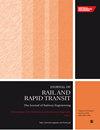简化列车通过时枕木形状和道碴深度对道碴飞行影响的计算流体动力学研究
IF 2.1
4区 工程技术
Q3 ENGINEERING, CIVIL
Proceedings of the Institution of Mechanical Engineers Part F-Journal of Rail and Rapid Transit
Pub Date : 2024-03-27
DOI:10.1177/09544097231226148
引用次数: 0
摘要
本文评估了改变道碴深度和枕木形状对简化高速列车下方气流系统的影响,以及造成道碴飞起或拾起的可能性。研究使用商业计算流体动力学(CFD)软件 AnSys Fluent 进行数值计算。通过轨道上方的移动墙生成了列车底部的流动剖面。使用带有 SST [计算公式:见正文]湍流模型的延迟分离涡模拟 (DDES) 模拟湍流,并在解析边界层时使用壁面粗糙度特征参数应用道碴床粗糙度。对立方体上的流动进行了 CFD 模拟验证,结果显示与实验结果非常吻合。对压载表面的三种不同深度和三种不同的枕木剖面进行了研究。放置在枕木块之间或顶部的立方体上的速度曲线和空气动力被用来评估单个道碴颗粒的移动倾向。对于标准的 G44 轨枕,增加道碴深度和/或道碴床粗糙度可减少单个道碴颗粒上的空气动力负荷。位于枕木顶部的道碴颗粒比位于道碴床表面的道碴颗粒更容易上浮。枕木上表面呈弧形的好处是可以防止压载物沉积在最容易受到影响的顶部。但是,由于弧形上表面减少了水流分离,因此可能会增加压舱物从轨枕中拾取的可能性。因此,旨在减少道碴飞散可能性的新枕木形状不仅要防止道碴沉积在顶部,还要通过提供尖锐的表面来增加水流分离度。建议采用棱柱形枕木,以实现这两个目的。本文章由计算机程序翻译,如有差异,请以英文原文为准。
A computational fluid dynamics study of the influence of sleeper shape and ballast depth on ballast flight during passage of a simplified train
The paper assesses the effect on the air flow regime underneath a simplified high-speed train of changing the ballast depth and the sleeper shape, with regard to its potential for causing ballast flight or pickup. The study was carried out numerically using the commercial Computational Fluid Dynamics (CFD) software AnSys Fluent. The flow profile beneath the underbody of the train was generated by means of a moving wall above the track. The Delayed Detached Eddy Simulation (DDES) with the SST [Formula: see text] turbulence model was used to simulate turbulent flow, and the ballast bed roughness was applied parametrically using the wall roughness feature when resolving the boundary layer. CFD simulations were validated for flow over a cube, showing good agreement with experimental results. Up to three different depths to the ballast surface and three different sleeper profiles were investigated. Velocity profiles and aerodynamic forces on cubes placed between or on top of the sleeper blocks were used to assess the propensity of individual ballast grains for movement. For a standard G44 sleeper, increasing the ballast depth and/or the ballast bed roughness was found to reduce aerodynamic loads on an individual ballast grain. A ballast grain on top of the sleeper is more prone to uplift than a grain on the surface of the ballast bed in the crib. A curved upper surface to the sleeper is beneficial in that it prevents ballast from settling on top, the most vulnerable position. However, the reduced flow separation associated with the curved top may increase the likelihood of ballast pickup from the crib. Hence new sleeper shapes intended to reduce the potential for ballast flight should not only prevent ballast from settling on top, but also increase flow separation through the provision of a sharp surface. A prismatic sleeper shape that achieves both is suggested.
求助全文
通过发布文献求助,成功后即可免费获取论文全文。
去求助
来源期刊

CiteScore
4.80
自引率
10.00%
发文量
91
审稿时长
7 months
期刊介绍:
The Journal of Rail and Rapid Transit is devoted to engineering in its widest interpretation applicable to rail and rapid transit. The Journal aims to promote sharing of technical knowledge, ideas and experience between engineers and researchers working in the railway field.
 求助内容:
求助内容: 应助结果提醒方式:
应助结果提醒方式:


